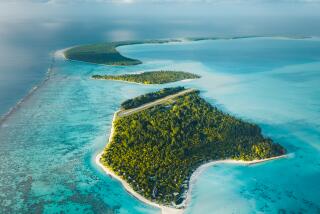Shultz Shows the Flag on Small, Vital Pacific Isles
KOROR, Palau — Local residents said their guest Saturday was the most important visitor to Palau since 1935, when the brother of Emperor Hirohito came to dedicate a Shinto shrine in what was then an outpost of imperial Japan.
Saturday’s visitor, Secretary of State George P. Shultz, sat on a stiff-backed chair, his face impassive and his hands folded primly in his lap, while seven young women in grass skirts and demure bras performed traditional Palauan dances.
Not much happens on Palau, a group of more than 200 Pacific islands. But in the 51 years between the visit of the Japanese prince and that of the U.S. secretary of state, Palau was the scene of bitter and bloody fighting in 1944 when U.S. forces seized the islands from Japan. Shultz, then a Marine Corps officer, was part of that invasion. And today, he is the point man in a U.S. diplomatic drive to prevent expansion of Soviet influence in the Pacific region, which, since World War II, has been an American lake.
Strategically Important
“Having fought for those islands and remembering the number of guys who laid their lives down there, I realized anew how strategically important they are,” Shultz said after a three-hour stay.
Under a plan approved by 72% of Palau’s voters in a referendum, the United States hopes to grant independence to Palau and two other Pacific island republics under an arrangement that allows Washington to handle their defense and foreign policy.
The territory is now administered by the United States under a U.N. trusteeship agreement. The Soviet Union opposes the independence plan and has threatened to block it with a veto in the Security Council.
The United States has only a token military presence on the islands now, but the independence plan gives Washington the option of installing major bases here, possibly if it loses base rights in the nearby Philippines. “My presence here represents concrete affirmation of the United States’ commitment to the future of the Pacific region,” Shultz told guests at a reception in the capital’s new luxury resort.
Several hundred Palauans, a substantial number for a nation with a population of less than 14,000, turned out at the airport on Babelthuap Island to welcome the Shultz party. Many of them carried miniature American flags. Local officials laid out a green carpet of woven palm fronds leading from the aircraft stairway to a makeshift podium where Shultz was to have made an arrival statement.
But just as the doors were opened on his Air Force jet transport, a tropical rainstorm broke, scattering the crowd and canceling the ceremony. A few minutes later, with the skies clearing, Shultz, accompanied by Palau President Lazarus Salii, was taken by speedboat across the blue-green water surrounding heavily forested islands, rising almost vertically from the sea.
Independence Plan
There is little more than a pleasure boat marina in the area now, but the water is deep enough to handle much larger ships.
Washington has administered Palau since 1947 as part of the Pacific Islands Trust Territory, a group of about 2,000 islets--most of them uninhabited--with a total population of less than 200,000.
The United States wants to end the trusteeship arrangement by granting independence to Palau, the Marshall Islands and the Federated States of Micronesia and by making the Northern Marianas a U.S. commonwealth like Puerto Rico. The three republics agreed to a “free association” with Washington that gives the United States responsibility for defense and foreign policy in exchange for substantial foreign aid.
The Soviet Union opposes the steps, all of them approved by the local population, because it contends that they will be tantamount to U.S. annexation. Moscow prefers to continue the present U.S. administration until an independence plan more to its liking is adopted.
And, under U.N. rules, the termination of a trusteeship agreement must be approved by the Security Council, where the Soviet Union has a veto. The plan also must be approved by Congress, and Administration officials said that is expected shortly.
“They are hoping we will just cast them (the islands) adrift so they (the Soviets) can gobble them up,” a senior U.S. official said.
The official said that if Moscow vetoes the independence plan, the United States will put the key provisions into effect anyway.
The Shultz party was greeted in Palau by signs reading, “Palauan Communists go home to Moscow” and by handbills declaring, “Pacific democracy is American democracy.” Nevertheless, the independence plan has proved to be more controversial in Palau than in the rest of the trust territory. Although 72% of the population approved the plan, the vote fell short of the 75% that some islanders argue was required for approval.
More to Read
Sign up for Essential California
The most important California stories and recommendations in your inbox every morning.
You may occasionally receive promotional content from the Los Angeles Times.








